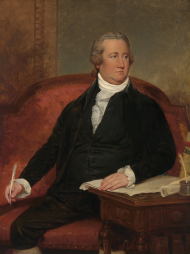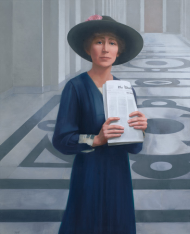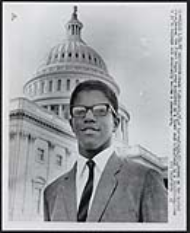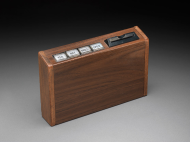House Trivia: U.S. House of Representatives
Congress and the House
 /tiles/non-collection/i/i_firsts_chamber_postcard_1906_hc.xml
McKinley Memorial Postcard, Collection of the U.S. House of Representatives
/tiles/non-collection/i/i_firsts_chamber_postcard_1906_hc.xml
McKinley Memorial Postcard, Collection of the U.S. House of Representatives About this object
New York City; Philadelphia; and its permanent location of Washington, D.C. which was established in the Residence Act of 1790.
First meeting of Congress:
The first meeting of Congress was on March 4, 1789, in New York City.
First quorum of Congress:
The first quorum of Congress was on April 1, 1789, in New York City.
The Congressional Record—the official record of the proceedings and debates of the House and Senate—was first printed on March 5, 1873.
The House was apportioned to its current size of 435 Representatives by the Permanent Apportionment Act of 1929.
House Leaders
 /tiles/non-collection/o/oh_ed_muhlenberg_hc.xml
Frederick Augustus Conrad Muhlenberg, Collection of the U.S. House of Representatives
/tiles/non-collection/o/oh_ed_muhlenberg_hc.xml
Frederick Augustus Conrad Muhlenberg, Collection of the U.S. House of RepresentativesAbout this object
Frederick Augustus Conrad Muhlenberg of Pennsylvania was elected the first Speaker of the House on April 1, 1789.
Frederick A.C. Muhlenberg of Pennsylvania was elected presiding officer on April 1, 1789, the day the House organized itself during the First Federal Congress (1789–1791).
Elected Speaker of the House as a sign of respect from his colleagues on March 3, 1869, Theodore M. Pomeroy of New York has the shortest term as Speaker. He held the position on the closing day of the 40th Congress (1867–1869).
First officially designated Republican floor leader:
James A. Tawney of Minnesota, 55th Congress (1897–1899).
First officially designated Democratic floor leader:
Oscar Underwood of Alabama, 56th Congress (1899–1901).
Longest-serving Speaker of the House:
Samuel Rayburn of Texas (17 years, two months, and two days).
First woman Speaker of the House:
On January 4, 2007, Nancy Pelosi of California became the first woman to serve as Speaker of the House.
Representatives
 /tiles/non-collection/b/baic_artifacts_Rainey_Joseph_2004_098_000.xml
Joseph Hayne Rainey, Collection of the U.S. House of Representatives
/tiles/non-collection/b/baic_artifacts_Rainey_Joseph_2004_098_000.xml
Joseph Hayne Rainey, Collection of the U.S. House of RepresentativesAbout this object Joseph Rainey of South Carolina was the first African-American Member to serve in Congress.
Frederick Muhlenberg of Pennsylvania, Speaker of the House, and John Peter Gabriel Muhlenberg of Pennsylvania served simultaneously in the 1st and 3rd Congresses (1789–1791; 1793–1795).
First former Representative to serve as President:
Former President James Madison of Virginia began his presidential service on March 4, 1809.
First former President to serve as a Representative:
John Quincy Adams of Massachusetts began his House service on March 4, 1831.
First person to lie in state in the Capitol Rotunda:
Henry Clay of Kentucky (July 1, 1852).
First African-American Representative elected to Congress:
Joseph Rainey of South Carolina began his service in the House of Representatives on December 12, 1870.
First African-American Representative to speak on the House Floor:
Jefferson Long of Georgia in 1871.
 /tiles/non-collection/w/wic_cont1_1_rankin_hc.xml
Jeannette Rankin, Collection of the U.S. House of Representatives
/tiles/non-collection/w/wic_cont1_1_rankin_hc.xml
Jeannette Rankin, Collection of the U.S. House of RepresentativesAbout this object Jeannette Rankin of Montana, a suffragist and peace activist, was the first woman to serve in Congress.
Romualdo Pacheco of California began his House service on March 4, 1877.
First and only incumbent Representative to be elected President:
James A. Garfield of Ohio was elected President on November 2, 1880.
First woman elected to the House of Representatives:
Jeannette Rankin of Montana in 1916.
First woman to preside over the House of the Representatives:
Alice Robertson of Oklahoma in 1922.
First Asian-Pacific American Representative:
Dalip Saund of California began his House service on January 3, 1957.
First Representative to be elected by a write-in vote:
Thomas Alford of Arkansas won election to the 86th Congress (1959–1961) as a write-in candidate on November 4, 1958.
 /tiles/non-collection/o/oh_ed_chisolm_hc.xml
Shirley Anita Chisholm, Collection of the U.S. House of Representatives
/tiles/non-collection/o/oh_ed_chisolm_hc.xml
Shirley Anita Chisholm, Collection of the U.S. House of RepresentativesAbout this object Shirley Chisholm of New York was the first African-American woman elected to Congress.
Shirley Chisholm of New York (1968).
Youngest person elected to the House of Representatives:
Representative William Charles Cole Claiborne of Tennessee. He was elected to the 5th Congress (1797–1799) at the age of 22. Despite not meeting the constitutional age requirement of 25 for the House, he was seated.
Oldest person recorded to have served in the House of Representatives:
Representative Charles Manly Stedman of North Carolina. Representative Stedman died in office on September 23, 1930, at the age of 89 years, 7 months, and 25 days. More recently, Representative Sidney Yates of Illinois was 89 years, 4 months, and 7 days old when he retired from his seat at the end of the 105th Congress (1997–1999).
Representative Frances Bolton of Ohio and her son, Representative Oliver Bolton of Ohio, are the only mother-son pair to have served simultaneously in Congress (January 3, 1953 to January 3, 1957, and January 3, 1963 to January 3, 1965)
House Committees
Oldest standing committee in the United States House of Representatives:
The Committee on Ways and Means was originally created as a select committee in the 1st Congress on July 24, 1789. It became a standing committee in the 4th Congress (1795–1797).
First woman to chair a standing committee in the House of Representatives:
Mae Ella Nolan of California became chairwoman of the Committee on Expenditures in the Post Office in 1923. She also became the first woman to succeed her husband in the House when she won a special election on January 23, 1923, to fill the vacancy left by the death of her husband, John Nolan of California.
First African American to chair a standing committee in the House of Representatives:
William Dawson of Illinois became chairman of the Expenditures in the Executive Departments Committee (later named Government Operations) in 1949.
House Officers and Staff
 /tiles/non-collection/2/2008_188_001.xml
Frank Mitchell, Collection of the U.S. House of Representatives, Photography Collection
/tiles/non-collection/2/2008_188_001.xml
Frank Mitchell, Collection of the U.S. House of Representatives, Photography CollectionAbout this object Appointed on April 14, 1965, Frank Mitchell became the first African American in the 20th century to serve as a Page in the House of Representatives.
John Beckley (April 1, 1789)
First House Chaplain:
William Linn (May 1, 1789)
First Sergeant at Arms:
Joseph Wheaton (May 12, 1789)
First African-American Page for the House:
Alfred Q. Powell (April 1, 1871)
First African-American Page for the House in the 20th century:
Frank Mitchell (April 14, 1965)
First female House Page:
Felda Looper (May 21, 1973)
Beginning in the 70th Congress (1927–1929), the title of Parliamentarian was used for the House official responsible for providing nonpartisan advice to Members on legislative proceedings. Longtime House Parliamentarian, Lewis Deschler was the first person to use this title.
On December 5, 1928, the House passed a resolution directing the Secretary of the Navy to assign a medical officer to provide health care for Representatives. Dr. George Calver, a George Washington University School of Medicine graduate, became the Capitol’s first Attending Physician.
Technology
 /tiles/non-collection/o/oh_inst_tech_electronic_voting_hc.xml
Electronic Voting Machine, Collection of the U.S. House of Representatives
/tiles/non-collection/o/oh_inst_tech_electronic_voting_hc.xml
Electronic Voting Machine, Collection of the U.S. House of RepresentativesAbout this object
On May 24, 1844, inventor Samuel Morse sent the first official telegraph from the Capitol to his partner in Baltimore, MD.
First live television broadcast from the House Chamber:
On January 3, 1947, the first live television broadcast from the House Chamber occurred during the opening session of the 80th Congress (1947–1949).
First electronic vote in the House of Representatives:
January 23, 1973.
On March 19, 1979, the House inaugurated live televised, “gavel-to-gavel” debate on the House Floor. Albert Gore, Jr. of Tennessee made history as the first Member to speak during the first live televised session.
The House Chamber and the Capitol Campus
During the Civil War, the Capitol Building briefly was used as a bakery, hospital, and military barracks.
The House of Representatives met in what in what is now Statuary Hall from 1807 to 1857. Members moved to the modern chamber on December 16, 1857. Representatives used desks in the House Chamber until 1913 when theater-style benches replaced the desks.
On January 9, 1908, Claude Kitchin of North Carolina became the first person to select a room in the first-ever congressional office building. The building—later named after Speaker Joseph Cannon—opened on December 12, 1908.
For many years, the Capitol attic room served as storage space for early House Records.
Ceremonies, Meetings, and Traditions
 Image courtesy of the Library of Congress
John Tener, Chicago White Stockings Baseball Card
Image courtesy of the Library of Congress
John Tener, Chicago White Stockings Baseball Card
On December 10, 1824, the Marquis de Lafayette, the French general and Revolutionary War hero, became the first foreign dignitary to address the House of Representatives in its chamber.
Originally a Capitol tradition, the annual Easter egg roll shifted to the White House when the House passed the Turf Protection Law on April 21, 1876, outlawing the use of the Capitol grounds for any activity which may damage the surrounding landscape.
Since 1904, the cafeterias at the United States House of Representatives have served bean soup on a daily basis. Upon finding that it was eliminated from the menu on a hot day, Speaker Joseph Cannon of Illinois started the tradition when he declared that bean soup be served everyday regardless of weather.
Representative John Tener of Pennsylvania, a former professional baseball player, organized the inaugural Congressional Baseball Game between Democrats and Republicans in 1909.
Since 1934, the Annual Message or State of the Union address is delivered every January or February. President Lyndon B. Johnson gave the first evening State of the Union address on January 4, 1965.
Ronald Boucher of Vermont is the youngest gold medal recipient in congressional history. On May 6, 1941, the House passed legislation to authorize awarding a Congressional Gold Medal to the 11-year-old boy in recognition of his bravery in rescuing several playmates who had fallen through the ice while ice skating.
Members of the House can introduce legislation by placing it in a box called the hopper attached to the side of the Clerk’s desk on the House rostrum. A name derived from a storage bin that usually holds grain or coal, the hopper has been used in the House since the 19th century.
The record for the most flags flown over the Capitol was set on July 4, 1976. 10,471 flags were flown over the Capitol to celebrate America’s Bicentennial.










